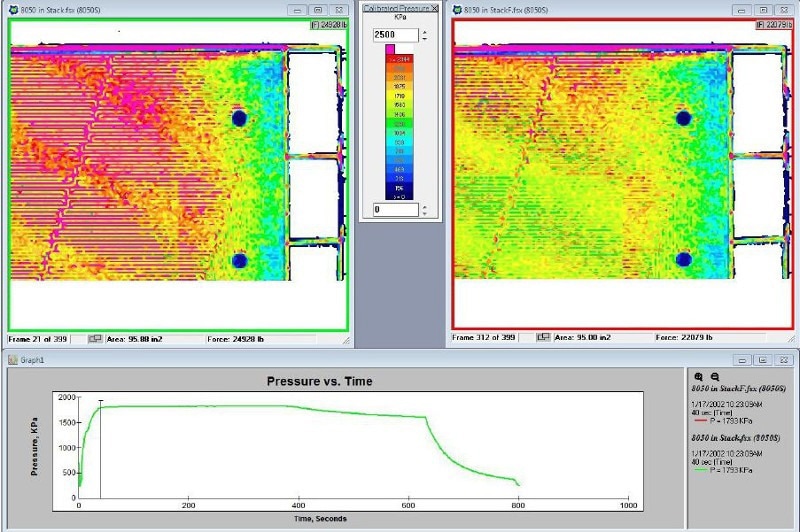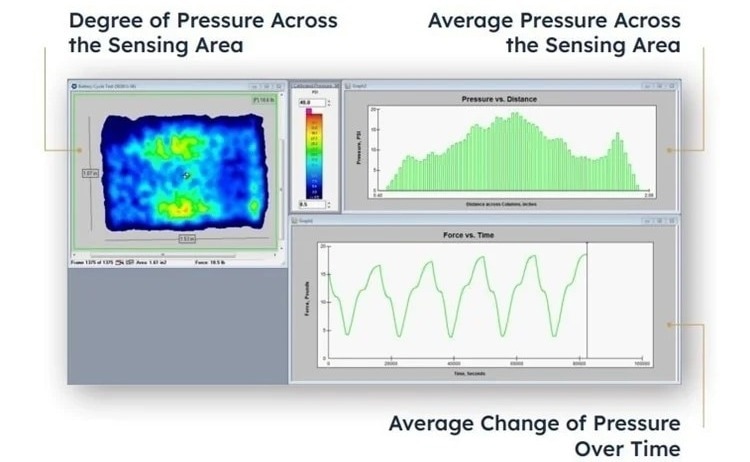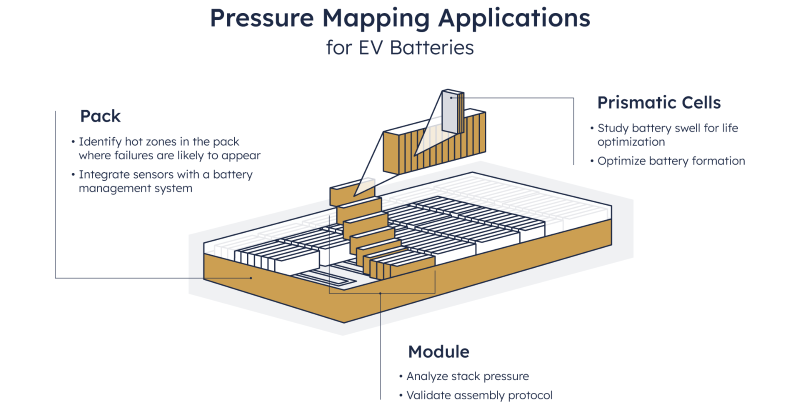Whether designing batteries for new electric vehicles (EVs), industrial applications, consumer electronics, or any pioneering product within the fast-paced battery industry, engineers share common goals: enhancing performance, prolonging lifespan, and ensuring safety.
Lithium-ion batteries charge and discharge cycles necessitate precise monitoring of heat and pressure during both the prototyping and manufacturing phases. Tracking pressure fluctuations within the battery housing provides critical insights throughout various stages of the process, including design, production, quality assurance, and the battery formation phase.
The I-Scan pressure measurement system from Tekscan allows engineers to monitor battery systems across all stages in the design and development process, helping to drive the commercialization of new innovations in the field.

Pressure around ports and in flow field before and after pressurization. Image Credit: Tekscan, Inc.
The Importance of Battery Pressure

Image Credit: Tekscan, Inc.
During regular use, charging and discharging a typical lithium-ion battery generates thermal cycling, causing expansion and contraction that may result in delamination and degradation over time.
The liquid electrolyte in Li-ion batteries is especially susceptible to expansion. If not properly considered in the design of the battery fixture, localized high and low pressures within the stack can lead to early failures.
Optimized assembly stack pressure can:
- Low Cell Variability
- Optimize formation costs
- Prevent Thermal Runaway
- Reduce Capacity Fade
- Restrict Thermal Expansion/ Delamination
Measuring Battery Pressure in Real-Time
Engineers are well aware of the crucial role pressure changes play in battery performance and safety. The challenge, however, is accurately tracking these changes. Tekscan meets this need with its sophisticated embedded force and pressure sensors, accompanied by intuitive software, facilitating precise data capture and insightful analysis.
In the video below, the system can be seen to measure:
- Pressure points across the sensing area
- Average changes in pressure across the sensing area
- Average changes in pressure over time

Image Credit: Tekscan, Inc.
Measuring battery pressure expansion with pressure mapping sensors and software
Video Credit: Tekscan, Inc.
EV Applications for Pressure Mapping

Pressure mapping applications for EV Batteries. Image Credit: Tekscan, Inc.
Prismatic Cells
- Analyze battery swell for life optimization
- Enhance battery formation
Module
- Assess stack pressure to ensure uniformity
- Confirm adherence to assembly protocols
Pack
- Detect potential failure points by identifying hot zones within the pack.
- Incorporate sensors into the battery management system for enhanced monitoring and control.
Pressure Mapping in Battery Lifecycle
The thin, flexible sensor provides comprehensive data, wrapping around the cell and between layers for a 360-degree view of battery pressure. It measures forces from adjacent cells in the stack, identifying potential failure points like pockets of gas formation and imperfections in component surfaces.

Flexible Tekscan matrix sensor wraps around battery components. Image Credit: Tekscan, Inc.
Tekscan's cutting-edge sensor, the model 7800, engineered for the battery market, boasts a unique 90-degree angled tab extension. This innovative design streamlines the incorporation of data collecting electronics into battery housings, significantly improving placement convenience and operational efficiency.
- The system enables data collection in multi-month lifecycle testing.
- Multiple charge and discharge profiles can be executed to compare battery performance.
- It allows correlation of pressure build with capacity and impedance.
Stack Pressure Validation
During assembly, sensors may be positioned between cells or modules to verify the accurate application of initial stack pressure within the fixture.

Image Credit: Tekscan, Inc.
Quality Control for Manufacturing
- Identify cell manufacturing defects
- Improve yields during the formation process
- Verify specified stack pressure in cell fabrication
Battery Management System
- Sensors integrated into the assembly to monitor pressures during operation.
- Safety control o restrict battery output in case of detected pressure spikes.
Battery Design Pressure Measurement Applications
Whether the focus is on liquid electrolyte lithium-ion batteries, alternative Li-ion chemistries like silicone anodes, the latest solid-state compositions, or the exploration of future component technologies, Tekscan’s pressure mapping system can be used to empower researchers to test, diagnose, and innovate battery designs in the following ways:
- How Pressure Mapping Insights Improve Battery Performance and Safety - Charging and discharging can cause changes in temperature, electrochemistry, or volume expansion. The measurement of pressure changes provides valuable insights into how the mechanics of the internal components are affected.
- Improving Lithium-Ion Battery Life and Performance - Discover the optimal battery stack pressure within your housing to enhance performance and durability.
- Pressure Testing to Reduce Thermal Runaway Risks - Defects can cause dangerous thermal runaway in lithium-ion batteries. Thus, testing expansion is essential.
- Measuring Relative Force Feedback from Swelling Within Lithium-Ion Battery Housing - Tekscan's ultra-thin embedded sensors can generate alerts for pressure changes before they escalate to hazardous levels.
- Battery Formation - Maintaining uniform pressure throughout the battery formation process can decrease formation time and enhance efficiency.
Pressure Mapping for EV Design
Apart from the core battery stack assembly and design, pressure mapping system analysis plays a crucial role in various facets of electric vehicle design, including safety testing and quality assurance.
- Improved seat and seatbelt design: The evolving design of electric vehicles (EVs) and autonomous vehicles alters the dynamic relationship between seat back and cushion pressure.
- Tire design: EVs require tires that are engineered differently due to variations in torque and other factors compared to those intended for combustion engines.
- Impact testing and chassis design - Testing sensors to assess the impact underneath the car from debris can be crucial when determining battery placement and ensuring adequate protection.
- Door design and door seal measurement - Weaknesses in door seal pressure design can affect factors such as noise levels, leaks, and aerodynamic efficiency.

Image Credit: Tekscan, Inc.
The design disparities and challenges faced by the next generation of EVs can differ significantly from previous designs. Utilizing pressure mapping data can be invaluable when it comes to addressing a multitude of needs, spanning from developing new designs for charging ports to comprehensively re-engineering every element of EVs and future vehicles.

This information has been sourced, reviewed and adapted from materials provided by Tekscan, Inc.
For more information on this source, please visit Tekscan, Inc.